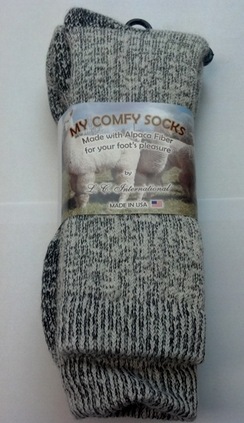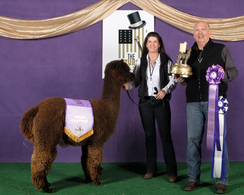Heat Stress in Alpacas
Monday, August 11, 2014
Alpacas and llamas, part of the group of animals referred to as New World camelids, originated from the high elevations of Chile and Peru in South America. Known for their luxurious fiber, these relatives of the camel are equipped for the biting winds and chilly temperatures that are typical in the Andes. But displace these animals to the warmth and humidity of a typical North American summer and you can get problems. These animals are very prone to heat stroke.
At first, an alpaca or llama with heat stroke may appear lethargic. If it moves around, it may seem disoriented or clumsy. If not treated, heat stroke can lead to organ failure, brain damage, and death. Understandably, this can be a very serious condition.
If an owner notices these signs in an animal on a hot day, immediate cool down is in order. This means hosing the animal with cold water. An important side note to this direction is to apply cold hosing to the legs and belly, not directly on top of the animal. The reason for this is the fiber will soak up the water and actually act as insulation, making the animal even hotter. If a vet is called out, cool IV fluids can be administered to lower the body temperature.
Despite this environmental danger, there are many ways owners can help prevent heat stroke in their animals. Firstly, when spring comes along, the animals should be shorn to keep their thick coats short. Alpacas and llamas can grow several pounds of fiber and this gets very hot when the temperature starts to rise. Secondly, since alpacas especially tend to become stressed with excessive handling, no typical herd work should be done during hot weather. This means no vaccines, no hoof trimming, no weighing, and no breeding. As a side note, heat stress can have a negative effect on fertility anyway.
Thirdly, make sure there are places in the field with plenty of shade. Many alpaca barns I’ve been in are extremely comfortable in the summer; owners set up large fans at either end of the building and a really nice cross breeze helps keep temperatures comfortable.
Drinking water is another important aspect in the heat. All animals should have access to fresh water at all times. Some owners fill up plastic kiddie pools with water to create mini baths for the animals to sit in if they need a cool down.
Owners should also keep a close eye on the herd in times of excessive heat. If you catch heat stress early, it can be treated with a high success rate, so early detection is key. This is especially important for crias, another term for young alpacas/llamas. Crias love to sit out in the sun and soak up rays, but for some reason, and I’m not sure why, crias don’t seem to know when enough is enough.
In the late afternoon, owners may find a cria out dozing in the hot sun with a very high body temperature. They can easily become sluggish and dehydrated and a dehydrated cria can go downhill very fast. Some owners will keep their crias in a well-ventilated barn on extremely hot days to prevent this.
Written by Dr. Anna O'Brien, submitted to Petmed.com
At first, an alpaca or llama with heat stroke may appear lethargic. If it moves around, it may seem disoriented or clumsy. If not treated, heat stroke can lead to organ failure, brain damage, and death. Understandably, this can be a very serious condition.
If an owner notices these signs in an animal on a hot day, immediate cool down is in order. This means hosing the animal with cold water. An important side note to this direction is to apply cold hosing to the legs and belly, not directly on top of the animal. The reason for this is the fiber will soak up the water and actually act as insulation, making the animal even hotter. If a vet is called out, cool IV fluids can be administered to lower the body temperature.
Despite this environmental danger, there are many ways owners can help prevent heat stroke in their animals. Firstly, when spring comes along, the animals should be shorn to keep their thick coats short. Alpacas and llamas can grow several pounds of fiber and this gets very hot when the temperature starts to rise. Secondly, since alpacas especially tend to become stressed with excessive handling, no typical herd work should be done during hot weather. This means no vaccines, no hoof trimming, no weighing, and no breeding. As a side note, heat stress can have a negative effect on fertility anyway.
Thirdly, make sure there are places in the field with plenty of shade. Many alpaca barns I’ve been in are extremely comfortable in the summer; owners set up large fans at either end of the building and a really nice cross breeze helps keep temperatures comfortable.
Drinking water is another important aspect in the heat. All animals should have access to fresh water at all times. Some owners fill up plastic kiddie pools with water to create mini baths for the animals to sit in if they need a cool down.
Owners should also keep a close eye on the herd in times of excessive heat. If you catch heat stress early, it can be treated with a high success rate, so early detection is key. This is especially important for crias, another term for young alpacas/llamas. Crias love to sit out in the sun and soak up rays, but for some reason, and I’m not sure why, crias don’t seem to know when enough is enough.
In the late afternoon, owners may find a cria out dozing in the hot sun with a very high body temperature. They can easily become sluggish and dehydrated and a dehydrated cria can go downhill very fast. Some owners will keep their crias in a well-ventilated barn on extremely hot days to prevent this.
Written by Dr. Anna O'Brien, submitted to Petmed.com





